SEO
7 Ways to Use Google Trends for SEO & Content Marketing via @sejournal, @martinibuster
Google Trends is the only keyword research tool that offers insights based on actual Google search data.
These seven tips on how to use Google Trends will show you how to extract real keyword trends that are accurate and will be useful for creating keyword strategies for promoting websites.
Discover new ways to use Google Trends to unlock hidden insights and keyword volume data.
The Value of Google Trends
While Google Trends is accurate, it doesn’t show the amount of traffic in actual numbers.
Paid SEO tools provide numbers for keyword search volume. But those numbers are estimates that are extrapolated from data providers.
So even though paid SEO tools provide estimates of keyword traffic, the data presented by Google Trends is based on actual search query volumes.
That’s not to say that Google Trends is better than paid keyword tools. When used together with paid keyword tools, one can obtain a near accurate idea of true keyword search volume.
Advertisement
Continue Reading Below
There are other functions in Google Trends that can allow accurate segmentation of the keyword data in order to understand what locations to focus promotional efforts, and also to discover new and trending keywords.
How to Use Google Trends for SEO
1. Get More Accurate Data by Comparing Keywords
Google Trends shows a relative visualization of traffic on a scale of zero to one hundred.
You can’t really know if the trend is reporting hundreds of keyword searches or thousands because the graph is on a relative scale.
This is especially helpful if you know the amount of traffic from another keyword phrase.
How to Obtain More Accurate Traffic Data
If you want to obtain a more accurate estimate of keyword search volume, compare the keyword with a keyword that you already have accurate volume numbers for.
If the keyword volume is especially large, there’s another way to identify a close estimate of keyword volume – by comparing your target keyword with any keyword phrase that you have an idea of traffic volume.
Advertisement
Continue Reading Below
The comparison keyword doesn’t have to be related. It can be completely different. The important thing is to have a general idea of the keyword volume.
In the event that this volume information is unavailable, here is a hack for getting an idea of search volume.
Go to the Google Trends Daily Trends webpage, which shows trending search queries.
What’s useful about this page is that Google provides keyword volumes in numbers, like 100,000+ searches per day, etc.
Here’s an example:
Google Trends shows that the keyword search trend for [womens dresses] is trending upward. But it doesn’t tell you by how much volume.
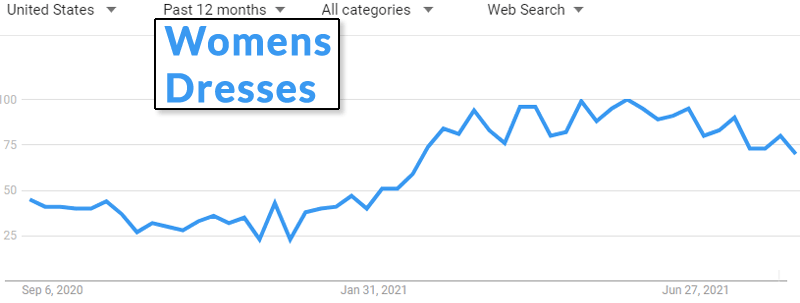 Screenshot from Google Trends, August 2021
Screenshot from Google Trends, August 2021
The Google Daily Trends page for Monday, August 30, 2021 shows that searches for [elizabeth holmes] are trending at 100,000+ searches.
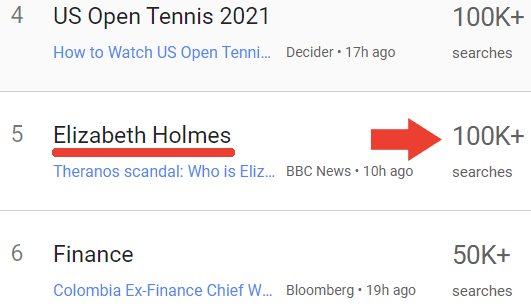 Screenshot from Google Trends, August 2021
Screenshot from Google Trends, August 2021
Now, here is a screenshot of a comparison between the search query [womens dresses] and [elizabeth holmes], which is trending at 100,000+ searches.
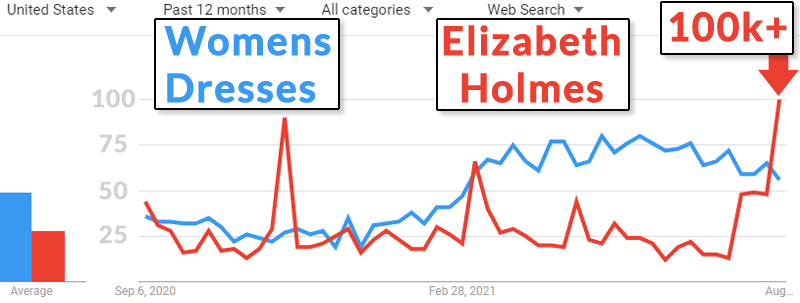 Screenshot from Google Trends, August 2021
Screenshot from Google Trends, August 2021
Although Google Trends won’t show you the exact amounts, as long as you know the amounts for one keyword, the traffic levels of the other keyword will become more understandable.
The above hack isn’t 100% accurate. But it’s enough to give a strong ballpark idea and can be used to validate extrapolated data from a paid keyword research tool.
Related: How to Do Keyword Research for SEO
2. Compare Keywords by Time for Audience Insights
There are two general ways to look at the keyword data: stretched across over longer periods of time and shorter time periods.
Long Period Trends
You can set Google Trends to show you the traffic trends stretching back to 2004. This is valuable for showing you audience trends.
- Upward Trending Long-Term Trends: If a trend is going up this means to focus energy on creating content for this trend.
- Downward Long-Term Trends: If the trend line is moving down, then it may be a signal that audience content consumption is changing.
For example, review this five-year trend for WordPress the search term, WordPress the software, and WordPress the website:
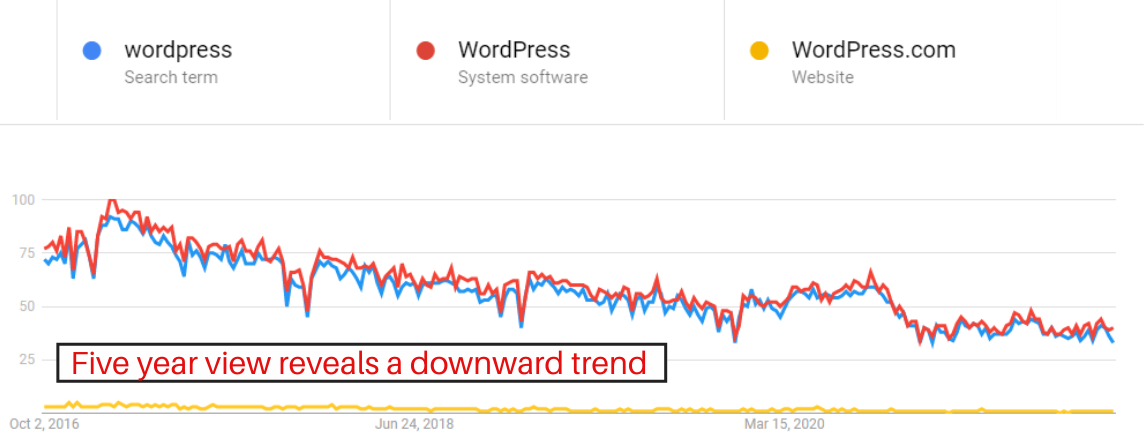 Screenshot from Google Trends, August 2021
Screenshot from Google Trends, August 2021
There’s a clear downward trend for WordPress in all its variations. The downward trend extends to phrases such as WordPress themes, WordPress plugin, and WordPress hosting.
Advertisement
Continue Reading Below
It’s super important to understand when a trend is on a downward spiral.
- The digital camera started the demise of the traditional analog camera.
- The iPhone started the downward spiral of the digital camera.
Knowing which way the wind is blowing could help a content marketer or publisher understand when it’s time to bail on digital cameras and start flogging products related to mobile phones.
Related: Content Marketing: The Ultimate Beginner’s Guide
3. Related Topics and Queries
Google Trends has two great features, one called Related Topics and the other Related Queries.
Topics
Topics are search queries that share a concept. In general, topics are language-independent but it’s unclear if that’s the case with Related Topics.
According to Google:
“Related Topics
Users searching for your term also searched for these topics.
You Can View by the Following Metrics
Top – The most popular topics. Scoring is on a relative scale where a value of 100 is the most commonly searched topic and a value of 50 is a topic searched half as often as the most popular term, and so on.
Rising – Related topics with the biggest increase in search frequency since the last time period.
Results marked “Breakout” had a tremendous increase, probably because these topics are new and had few (if any) prior searches.”
Advertisement
Continue Reading Below
Related Queries
The description of Related Queries is similar to that of the Related Topics.
Top queries are the most popular in general and Rising Queries are queries that are becoming popular.
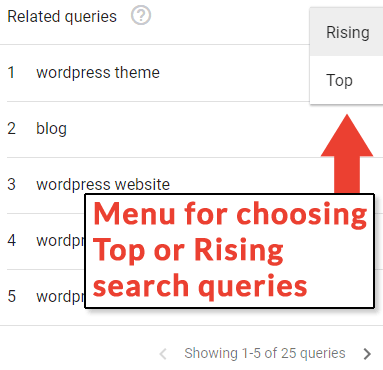 Screenshot from Google Trends, August 2021
Screenshot from Google Trends, August 2021
4. Short Term Trends Can Bring Massive Traffic
Viewing keyword trends in the short view, such as the 90 day or even 30 day view can reveal valuable insights for capitalizing on rapidly changing search trends.
Advertisement
Continue Reading Below
There is a ton of traffic in Google Discover as well as in Google News.
While Google Discover is less sensitive to trending topics than Google News, being on top of current interests is super helpful for grabbing a huge amount of traffic right now through Google Discover and Google News.
For example, two of the top trending keyword trends are How To and Near Me searches.
When you scale down to the 90-day view, you can see which days of the weeks those searches are popular.
Knowing which days of the week interest spikes for a given topic can also help in planning when to publish certain kinds of topics so the content is right there when the audience is searching for it.
5. Keywords by Category
Google Trends has the capability to narrow down your keywords according to categories in order to give more accurate data.
The Categories tab is important because it refines your keyword research to the correct context.
Advertisement
Continue Reading Below
If your keyword context is automobiles then it makes sense to appropriately refine Google Trends to show just the data for the context of auto.
By narrowing the Google Trends data by category, you will be able to find more accurate information related to the topics you are researching for content.
6. Leverage Keyword Data by Geography
Google Trends keyword information by geographic location can be used for determining what areas are the best to outreach to for site promotion or for tailoring the content to specific regions.
For example, if certain kinds of products are popular in Washington D.C. and Texas, it makes sense to aim promotional activity and localized content to those areas.
Keyword popularity information by region is valuable for link building, content creation, content promotion, and pay-per-click.
Localizing content can make it more relevant to people interested in that content.
Google ranks pages according to who it’s most relevant for, so incorporating geographic nuance into your content can help it rank for the most people. Especially if those people begin to promote your content in social media, blogs, and podcasts.
Advertisement
Continue Reading Below
Related: International SEO for 2021 & Beyond: 9-Point Checklist for Success
7. Uncover Search Intents With Categories
Google Trends gives you the ability to further refine the keyword data by segmenting it by Search Type, which is an incredibly useful way to research the popularity of various kinds of search intents.
Search Types give you insights into searchers when they are intensely focused on a specific kind of intent.
Refining your research allows you to remove the “noise” that might be polluting your keyword research and go straight to the signal – the data that is most meaningful.
Google Trends data can be refined by:
- Web Search.
- Image Search.
- News Search.
- Google Shopping.
- YouTube Search.
YouTube search is a fantastic way to identify the “how to” content.
A Google Trends search for how, what, where, when, why, and who shows that search queries beginning with the word “how” are by far the most popular on YouTube.
Advertisement
Continue Reading Below
Google Trends limits comparisons to five keywords, so the following screenshot omits that word.
 Screenshot from Google Trends, August 2021
Screenshot from Google Trends, August 2021
If your keyword phrases involve instructional content that uses words like [how to], refining your research to YouTube may provide useful insights.
For example, I have found that YouTube Search shows more relevant “related topics” and “related queries” data than researching with “web search” selected.
Here’s another example of how using different kinds of search types helps refine Google Trends data.
Advertisement
Continue Reading Below
I did the same how, what, where, when, why, and who searches but this time using the News Search refinement.
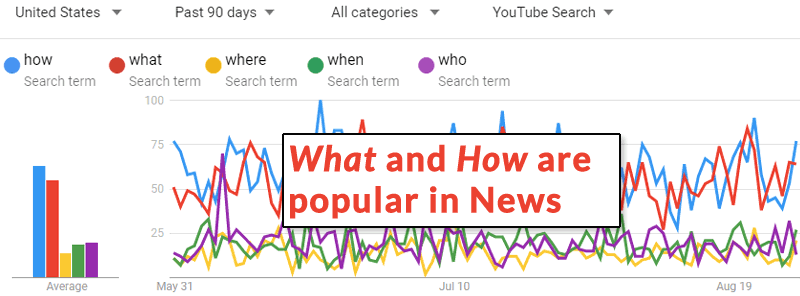 Screenshot from Google Trends, August 2021
Screenshot from Google Trends, August 2021
The search trends in Google News are remarkably different than the search patterns in YouTube. That’s because people want to know “what” and “how” type information in Google News.
The above is the view of search queries for the past 90 days. When the same keywords are searched using the 5-year perspective it becomes clear that the “who” type keywords tend to spike according to current events.
Advertisement
Continue Reading Below
The biggest spike occurred in the days after the 2020 presidential election.
All of the different search type query refinements help to refine the results so that they show more accurate information.
So give those selections a try because the information they give can be more accurate and useful than the more general and potentially noisy “web search” version.
Takeaway: Google Trends is Useful
Google Trends is a useful tool, and a little creativity yields important search marketing insights.
Spend some time with Google Trends. I’m certain you’ll discover insights that will improve how content is created and promoted online.
More Resources:
Featured image: alphaspirit.it/Shutterstock
SEO
Measuring Content Impact Across The Customer Journey

Understanding the impact of your content at every touchpoint of the customer journey is essential – but that’s easier said than done. From attracting potential leads to nurturing them into loyal customers, there are many touchpoints to look into.
So how do you identify and take advantage of these opportunities for growth?
Watch this on-demand webinar and learn a comprehensive approach for measuring the value of your content initiatives, so you can optimize resource allocation for maximum impact.
You’ll learn:
- Fresh methods for measuring your content’s impact.
- Fascinating insights using first-touch attribution, and how it differs from the usual last-touch perspective.
- Ways to persuade decision-makers to invest in more content by showcasing its value convincingly.
With Bill Franklin and Oliver Tani of DAC Group, we unravel the nuances of attribution modeling, emphasizing the significance of layering first-touch and last-touch attribution within your measurement strategy.
Check out these insights to help you craft compelling content tailored to each stage, using an approach rooted in first-hand experience to ensure your content resonates.
Whether you’re a seasoned marketer or new to content measurement, this webinar promises valuable insights and actionable tactics to elevate your SEO game and optimize your content initiatives for success.
View the slides below or check out the full webinar for all the details.
SEO
How to Find and Use Competitor Keywords

Competitor keywords are the keywords your rivals rank for in Google’s search results. They may rank organically or pay for Google Ads to rank in the paid results.
Knowing your competitors’ keywords is the easiest form of keyword research. If your competitors rank for or target particular keywords, it might be worth it for you to target them, too.
There is no way to see your competitors’ keywords without a tool like Ahrefs, which has a database of keywords and the sites that rank for them. As far as we know, Ahrefs has the biggest database of these keywords.
How to find all the keywords your competitor ranks for
- Go to Ahrefs’ Site Explorer
- Enter your competitor’s domain
- Go to the Organic keywords report
The report is sorted by traffic to show you the keywords sending your competitor the most visits. For example, Mailchimp gets most of its organic traffic from the keyword “mailchimp.”


Since you’re unlikely to rank for your competitor’s brand, you might want to exclude branded keywords from the report. You can do this by adding a Keyword > Doesn’t contain filter. In this example, we’ll filter out keywords containing “mailchimp” or any potential misspellings:


If you’re a new brand competing with one that’s established, you might also want to look for popular low-difficulty keywords. You can do this by setting the Volume filter to a minimum of 500 and the KD filter to a maximum of 10.


How to find keywords your competitor ranks for, but you don’t
- Go to Competitive Analysis
- Enter your domain in the This target doesn’t rank for section
- Enter your competitor’s domain in the But these competitors do section


Hit “Show keyword opportunities,” and you’ll see all the keywords your competitor ranks for, but you don’t.


You can also add a Volume and KD filter to find popular, low-difficulty keywords in this report.


How to find keywords multiple competitors rank for, but you don’t
- Go to Competitive Analysis
- Enter your domain in the This target doesn’t rank for section
- Enter the domains of multiple competitors in the But these competitors do section


You’ll see all the keywords that at least one of these competitors ranks for, but you don’t.


You can also narrow the list down to keywords that all competitors rank for. Click on the Competitors’ positions filter and choose All 3 competitors:


- Go to Ahrefs’ Site Explorer
- Enter your competitor’s domain
- Go to the Paid keywords report


This report shows you the keywords your competitors are targeting via Google Ads.
Since your competitor is paying for traffic from these keywords, it may indicate that they’re profitable for them—and could be for you, too.
You know what keywords your competitors are ranking for or bidding on. But what do you do with them? There are basically three options.
1. Create pages to target these keywords
You can only rank for keywords if you have content about them. So, the most straightforward thing you can do for competitors’ keywords you want to rank for is to create pages to target them.
However, before you do this, it’s worth clustering your competitor’s keywords by Parent Topic. This will group keywords that mean the same or similar things so you can target them all with one page.
Here’s how to do that:
- Export your competitor’s keywords, either from the Organic Keywords or Content Gap report
- Paste them into Keywords Explorer
- Click the “Clusters by Parent Topic” tab


For example, MailChimp ranks for keywords like “what is digital marketing” and “digital marketing definition.” These and many others get clustered under the Parent Topic of “digital marketing” because people searching for them are all looking for the same thing: a definition of digital marketing. You only need to create one page to potentially rank for all these keywords.


2. Optimize existing content by filling subtopics
You don’t always need to create new content to rank for competitors’ keywords. Sometimes, you can optimize the content you already have to rank for them.
How do you know which keywords you can do this for? Try this:
- Export your competitor’s keywords
- Paste them into Keywords Explorer
- Click the “Clusters by Parent Topic” tab
- Look for Parent Topics you already have content about
For example, if we analyze our competitor, we can see that seven keywords they rank for fall under the Parent Topic of “press release template.”


If we search our site, we see that we already have a page about this topic.


If we click the caret and check the keywords in the cluster, we see keywords like “press release example” and “press release format.”


To rank for the keywords in the cluster, we can probably optimize the page we already have by adding sections about the subtopics of “press release examples” and “press release format.”
3. Target these keywords with Google Ads
Paid keywords are the simplest—look through the report and see if there are any relevant keywords you might want to target, too.
For example, Mailchimp is bidding for the keyword “how to create a newsletter.”


If you’re ConvertKit, you may also want to target this keyword since it’s relevant.
If you decide to target the same keyword via Google Ads, you can hover over the magnifying glass to see the ads your competitor is using.


You can also see the landing page your competitor directs ad traffic to under the URL column.


Learn more
Check out more tutorials on how to do competitor keyword analysis:
SEO
Google Confirms Links Are Not That Important

Google’s Gary Illyes confirmed at a recent search marketing conference that Google needs very few links, adding to the growing body of evidence that publishers need to focus on other factors. Gary tweeted confirmation that he indeed say those words.
Background Of Links For Ranking
Links were discovered in the late 1990’s to be a good signal for search engines to use for validating how authoritative a website is and then Google discovered soon after that anchor text could be used to provide semantic signals about what a webpage was about.
One of the most important research papers was Authoritative Sources in a Hyperlinked Environment by Jon M. Kleinberg, published around 1998 (link to research paper at the end of the article). The main discovery of this research paper is that there is too many web pages and there was no objective way to filter search results for quality in order to rank web pages for a subjective idea of relevance.
The author of the research paper discovered that links could be used as an objective filter for authoritativeness.
Kleinberg wrote:
“To provide effective search methods under these conditions, one needs a way to filter, from among a huge collection of relevant pages, a small set of the most “authoritative” or ‘definitive’ ones.”
This is the most influential research paper on links because it kick-started more research on ways to use links beyond as an authority metric but as a subjective metric for relevance.
Objective is something factual. Subjective is something that’s closer to an opinion. The founders of Google discovered how to use the subjective opinions of the Internet as a relevance metric for what to rank in the search results.
What Larry Page and Sergey Brin discovered and shared in their research paper (The Anatomy of a Large-Scale Hypertextual Web Search Engine – link at end of this article) was that it was possible to harness the power of anchor text to determine the subjective opinion of relevance from actual humans. It was essentially crowdsourcing the opinions of millions of website expressed through the link structure between each webpage.
What Did Gary Illyes Say About Links In 2024?
At a recent search conference in Bulgaria, Google’s Gary Illyes made a comment about how Google doesn’t really need that many links and how Google has made links less important.
Patrick Stox tweeted about what he heard at the search conference:
” ‘We need very few links to rank pages… Over the years we’ve made links less important.’ @methode #serpconf2024″
Google’s Gary Illyes tweeted a confirmation of that statement:
“I shouldn’t have said that… I definitely shouldn’t have said that”
Why Links Matter Less
The initial state of anchor text when Google first used links for ranking purposes was absolutely non-spammy, which is why it was so useful. Hyperlinks were primarily used as a way to send traffic from one website to another website.
But by 2004 or 2005 Google was using statistical analysis to detect manipulated links, then around 2004 “powered-by” links in website footers stopped passing anchor text value, and by 2006 links close to the words “advertising” stopped passing link value, links from directories stopped passing ranking value and by 2012 Google deployed a massive link algorithm called Penguin that destroyed the rankings of likely millions of websites, many of which were using guest posting.
The link signal eventually became so bad that Google decided in 2019 to selectively use nofollow links for ranking purposes. Google’s Gary Illyes confirmed that the change to nofollow was made because of the link signal.
Google Explicitly Confirms That Links Matter Less
In 2023 Google’s Gary Illyes shared at a PubCon Austin that links were not even in the top 3 of ranking factors. Then in March 2024, coinciding with the March 2024 Core Algorithm Update, Google updated their spam policies documentation to downplay the importance of links for ranking purposes.
The documentation previously said:
“Google uses links as an important factor in determining the relevancy of web pages.”
The update to the documentation that mentioned links was updated to remove the word important.
Links are not just listed as just another factor:
“Google uses links as a factor in determining the relevancy of web pages.”
At the beginning of April Google’s John Mueller advised that there are more useful SEO activities to engage on than links.
Mueller explained:
“There are more important things for websites nowadays, and over-focusing on links will often result in you wasting your time doing things that don’t make your website better overall”
Finally, Gary Illyes explicitly said that Google needs very few links to rank webpages and confirmed it.
I shouldn’t have said that… I definitely shouldn’t have said that
— Gary 鯨理/경리 Illyes (so official, trust me) (@methode) April 19, 2024
Why Google Doesn’t Need Links
The reason why Google doesn’t need many links is likely because of the extent of AI and natural language undertanding that Google uses in their algorithms. Google must be highly confident in its algorithm to be able to explicitly say that they don’t need it.
Way back when Google implemented the nofollow into the algorithm there were many link builders who sold comment spam links who continued to lie that comment spam still worked. As someone who started link building at the very beginning of modern SEO (I was the moderator of the link building forum at the #1 SEO forum of that time), I can say with confidence that links have stopped playing much of a role in rankings beginning several years ago, which is why I stopped about five or six years ago.
Read the research papers
Authoritative Sources in a Hyperlinked Environment – Jon M. Kleinberg (PDF)
The Anatomy of a Large-Scale Hypertextual Web Search Engine
Featured Image by Shutterstock/RYO Alexandre
-

 PPC4 days ago
PPC4 days ago19 Best SEO Tools in 2024 (For Every Use Case)
-

 MARKETING7 days ago
MARKETING7 days agoWill Google Buy HubSpot? | Content Marketing Institute
-
SEARCHENGINES7 days ago
Daily Search Forum Recap: April 16, 2024
-

 SEO7 days ago
SEO7 days agoGoogle Clarifies Vacation Rental Structured Data
-

 MARKETING6 days ago
MARKETING6 days agoStreamlining Processes for Increased Efficiency and Results
-
SEARCHENGINES6 days ago
Daily Search Forum Recap: April 17, 2024
-

 SEO6 days ago
SEO6 days agoAn In-Depth Guide And Best Practices For Mobile SEO
-

 PPC6 days ago
PPC6 days ago97 Marvelous May Content Ideas for Blog Posts, Videos, & More















You must be logged in to post a comment Login